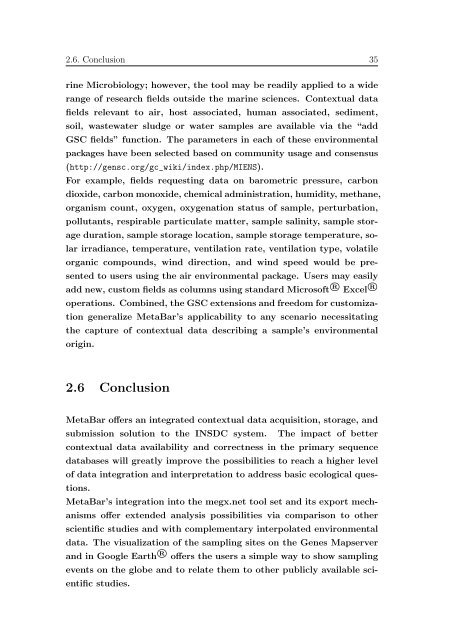Data integration in microbial genomics ... - Jacobs University
Data integration in microbial genomics ... - Jacobs University
Data integration in microbial genomics ... - Jacobs University
Create successful ePaper yourself
Turn your PDF publications into a flip-book with our unique Google optimized e-Paper software.
2.6. Conclusion 35<br />
r<strong>in</strong>e Microbiology; however, the tool may be readily applied to a wide<br />
range of research fields outside the mar<strong>in</strong>e sciences. Contextual data<br />
fields relevant to air, host associated, human associated, sediment,<br />
soil, wastewater sludge or water samples are available via the “add<br />
GSC fields” function. The parameters <strong>in</strong> each of these environmental<br />
packages have been selected based on community usage and consensus<br />
(http://gensc.org/gc_wiki/<strong>in</strong>dex.php/MIENS).<br />
For example, fields request<strong>in</strong>g data on barometric pressure, carbon<br />
dioxide, carbon monoxide, chemical adm<strong>in</strong>istration, humidity, methane,<br />
organism count, oxygen, oxygenation status of sample, perturbation,<br />
pollutants, respirable particulate matter, sample sal<strong>in</strong>ity, sample storage<br />
duration, sample storage location, sample storage temperature, solar<br />
irradiance, temperature, ventilation rate, ventilation type, volatile<br />
organic compounds, w<strong>in</strong>d direction, and w<strong>in</strong>d speed would be presented<br />
to users us<strong>in</strong>g the air environmental package. Users may easily<br />
add new, custom fields as columns us<strong>in</strong>g standard Microsoft R○ Excel R○<br />
operations. Comb<strong>in</strong>ed, the GSC extensions and freedom for customization<br />
generalize MetaBar’s applicability to any scenario necessitat<strong>in</strong>g<br />
the capture of contextual data describ<strong>in</strong>g a sample’s environmental<br />
orig<strong>in</strong>.<br />
2.6 Conclusion<br />
MetaBar offers an <strong>in</strong>tegrated contextual data acquisition, storage, and<br />
submission solution to the INSDC system. The impact of better<br />
contextual data availability and correctness <strong>in</strong> the primary sequence<br />
databases will greatly improve the possibilities to reach a higher level<br />
of data <strong><strong>in</strong>tegration</strong> and <strong>in</strong>terpretation to address basic ecological questions.<br />
MetaBar’s <strong><strong>in</strong>tegration</strong> <strong>in</strong>to the megx.net tool set and its export mechanisms<br />
offer extended analysis possibilities via comparison to other<br />
scientific studies and with complementary <strong>in</strong>terpolated environmental<br />
data. The visualization of the sampl<strong>in</strong>g sites on the Genes Mapserver<br />
and <strong>in</strong> Google Earth R○ offers the users a simple way to show sampl<strong>in</strong>g<br />
events on the globe and to relate them to other publicly available scientific<br />
studies.

















